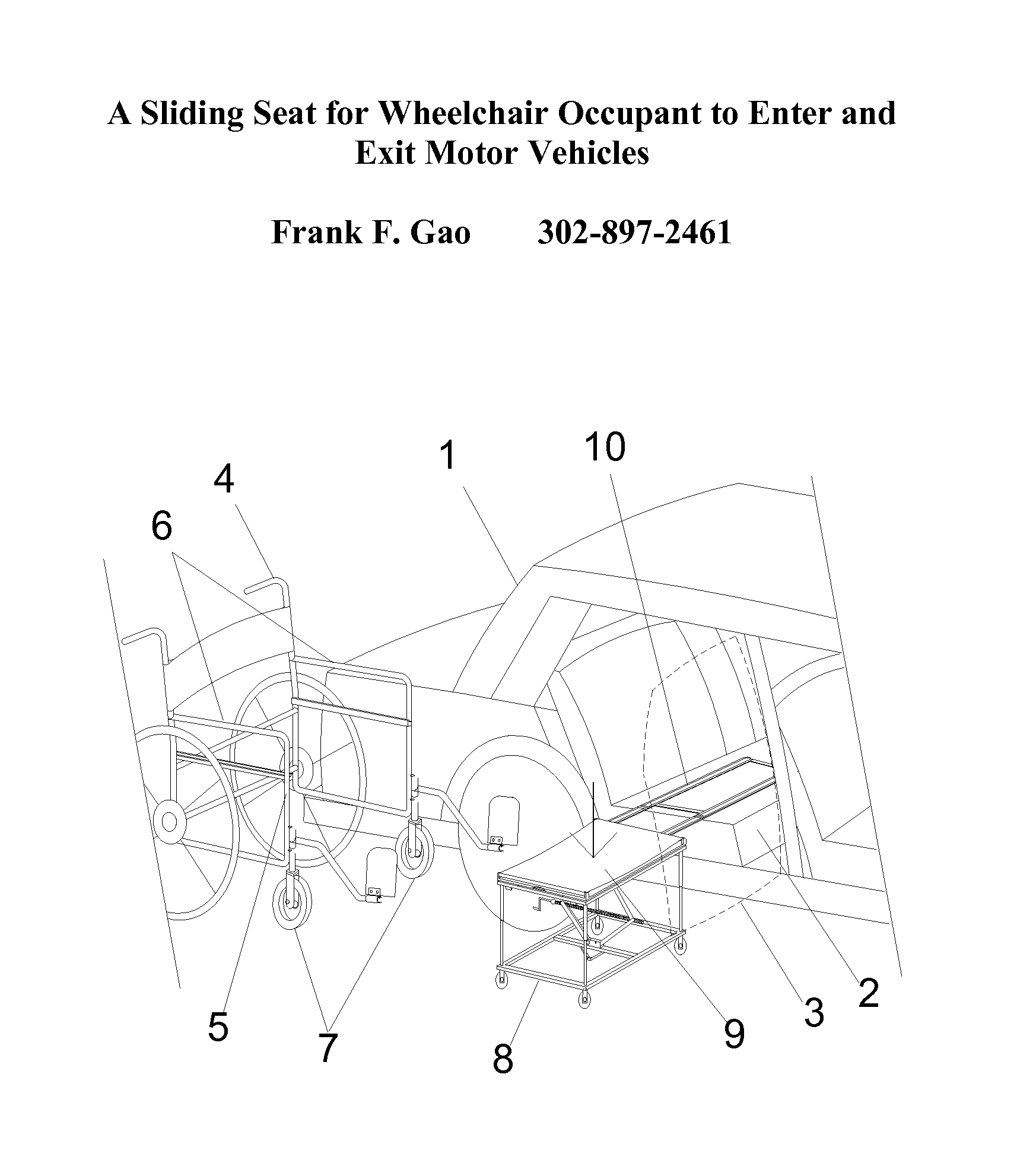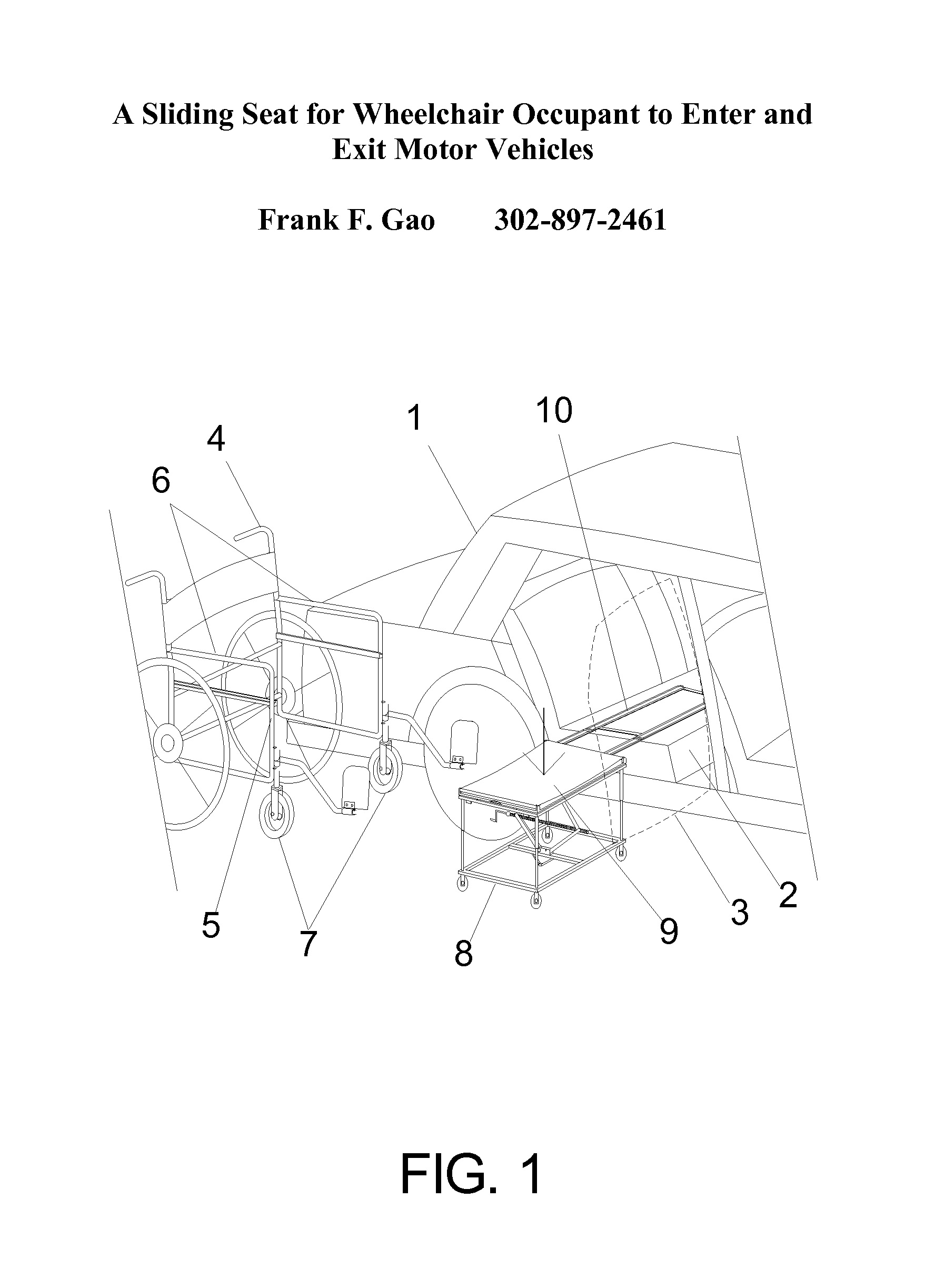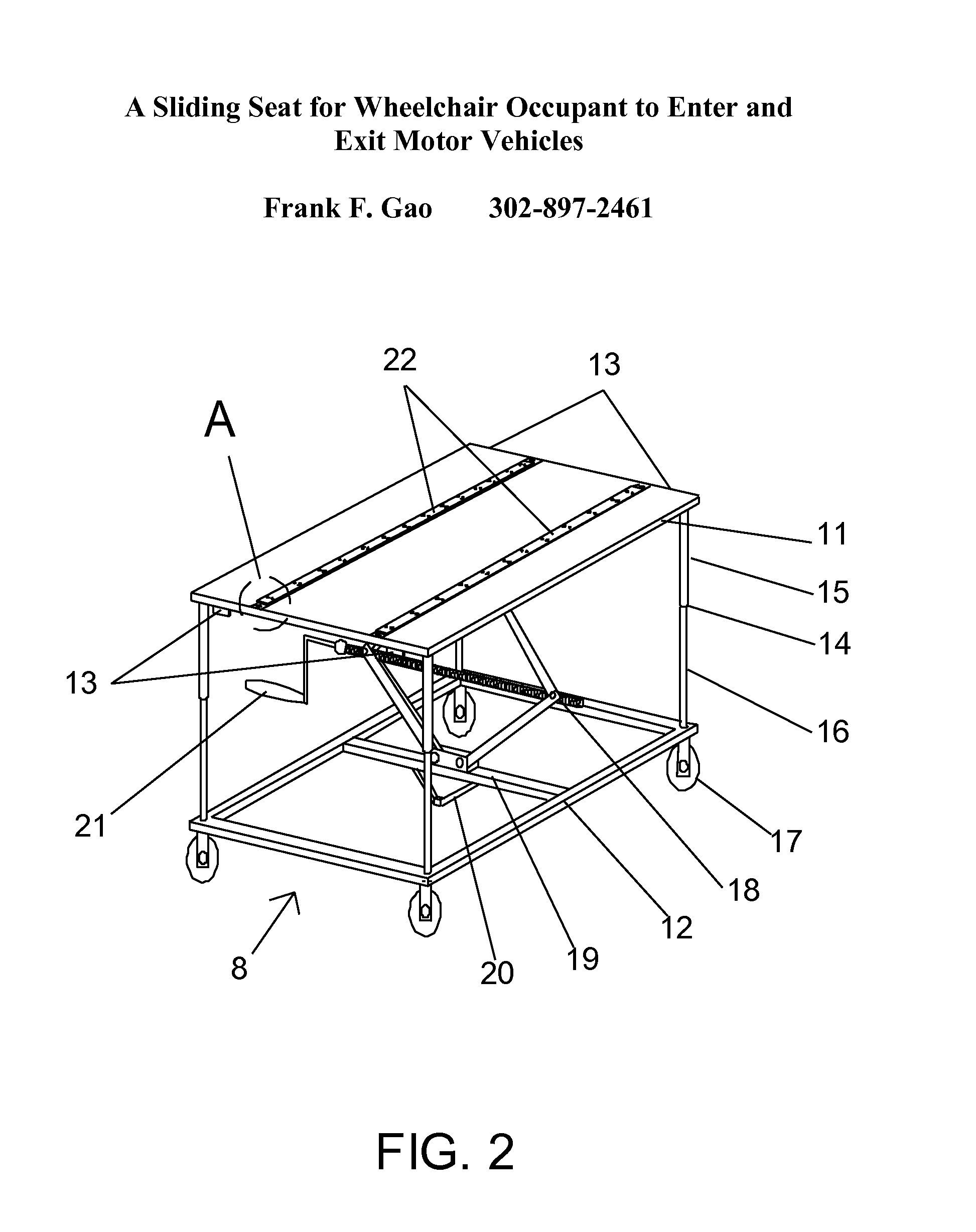[0009]The present invention aims at addressing the aforementioned need to transfer
disabled people between their wheelchairs and motor vehicles in which they ride to distant destinations. More specifically, the present invention provides a sliding seat, either as a component seat but detachable from wheelchair, or as an accessory seat separate from wheelchair. Sitting on this sliding seat, a wheelchair occupant can enter or exit a motor vehicle without leaving the seat cushion, therefore avoiding the labor-intensive lifting need. Operation of this sliding seat can be done by manual efforts, and can be done by one adult helper, who can be conveniently the driver of transporting vehicle.
[0012]When the wheelchair occupant needs to enter a vehicle, the corresponding vehicle door is opened widely first, then the wheelchair is pushed as close as possible to the side of the vehicle behind the open door. A helper operates manually the hoisting device of the supporting rack to lower its bottom frame until its four wheels reach the ground. After the wheels reach the ground, the helper continues operating the hoisting device to raise the top-board of the supporting rack until the sliding seat is disengaged from the wheelchair main frame. The occupant on the sliding seat is supported by the supporting rack only. At this point, the helper can pull the wheelchair backward to separate the wheelchair from the sliding seat. Then, the helper can operate the hoisting device again to adjust the height of the sliding seat to that of the vehicle seat. Then, the helper takes out the extender and attaches it to the top-board of the supporting rack, with its sliding rulers
lying on the vehicle seat where the disabled person will sit. At this point, the helper can make necessary small movements of the supporting rack to a position in which the disabled person feels comfortable during the sliding process to follow. Such small movements can be easily done due to the four all-direction wheels of the supporting rack. After this position adjustment, the wheelchair occupant can enter the vehicle easily while the helper pushes the seating means on the elongated sliding rulers. After entering the vehicle, the occupant will buckle up on the seating means, which sits on the elongated sliding rulers on the vehicle seat. Then, the extension frame is detached from the supporting rack, and folded up to allow the vehicle door to close. Both wheelchair and supporting rack can then be stowed in the vehicle's rear
trunk. The occupant and his / her equipment (wheelchair and supporting rack) are ready for a long-distance ride.
[0013]Upon arriving at the destination, an opposite process is followed to help the occupant exit the vehicle. After being unloaded from the vehicle rear
trunk, the supporting rack is first placed to the same position by the vehicle. The extender is folded down and attached to the supporting rack to resume connection of the sliding rulers. Then, the occupant, after being unbuckled, can easily exit the vehicle while the helper pulls the seating means on the elongated sliding rulers. After the occupant is seated safely on the supporting rack, the extender is detached from the supporting rack, and the supporting rack is moved away slightly from the vehicle, where the occupant can still use his / her hand to hold the vehicle door frame for stability. Then, the helper can operate the hoisting device to adjust the top-board of the supporting rack to a height at which the wheelchair can be moved underneath. After the wheelchair is placed underneath the top-board of the supporting rack, the top-board is lowered for reengagement by operating the hoisting device. After the reengagement, further operation of the hoisting device will raise the four wheels of the supporting rack. At this point, the extender can be removed from the vehicle seat and then stowed on the bottom frame of the supporting rack. The wheelchair occupant is ready for leaving for desired activities, and the vehicle itself is ready for its parking.
[0015]The advantages of the present invention include the following. First, with the present invention as a component of a new wheelchair, the wheelchair occupant will no longer have to leave the wheelchair seat cushion when entering or exiting a motor vehicle, thus completely avoiding the need of lifting the body of the occupant. When the present invention is provided as an accessory, the lifting effort for
relocation can be significantly reduced, particularly when the two arms of the wheelchair occupant can still function properly. Secondly, the difference in height between the wheelchair occupant's seat and the vehicle seat can be adjusted by a hoisting device that can be operated manually and easily by an adult helper. Although a powered hoisting device may be an alternative, its use is no longer a necessity. Thirdly, the sliding mechanism of the present invention makes the vehicle entering or exiting process so simple and labor-saving that one adult helper can easily
handle. Fourthly, the present invention will make the long-distance transportation of wheelchair occupants practically feasible with a much wider range of motor vehicles, including some compact cars because at least the front passenger seats of those compact cars can be readily used with the present invention. Finally, and most importantly, the present invention provides a sliding process in which a wheelchair occupant can transfer from the wheelchair into a motor vehicle, or from inside the vehicle back to wheelchair, with minimum
body position changes, and thus minimum physical and psychological discomforts. With all those advantages, the present invention is expected to significantly enhance the moving ability of disabled people, thus enabling them to enjoy with, and contribute to, more and more the societal activities, public welfares, and modern civilization.
[0016]The sliding seat of the present invention will lead to a cost-effective improvement in the present arts of wheelchairs and related equipments for wheelchaired people to enter or exit motor vehicles because (1) it does not require any powered part or mechanism, although some powered devices may be alternative; (2) it does not require any alternation or equipment installation on the vehicle end; (3) its design and structure are relatively simple, and therefore can be easily manufactured in a wheelchair factory with existing equipments. In addition, using the sliding seat of the present invention will lead to other savings, including savings from every step of transporting a wheelchaired person for a long distance, plus savings in time, effort and man-power needed.
[0017]The wheelchair being associated with the present invention should be foldable so that it can be easily stowed
in vehicle's
trunk and transported together with the wheelchair occupant.
 Login to View More
Login to View More  Login to View More
Login to View More 


